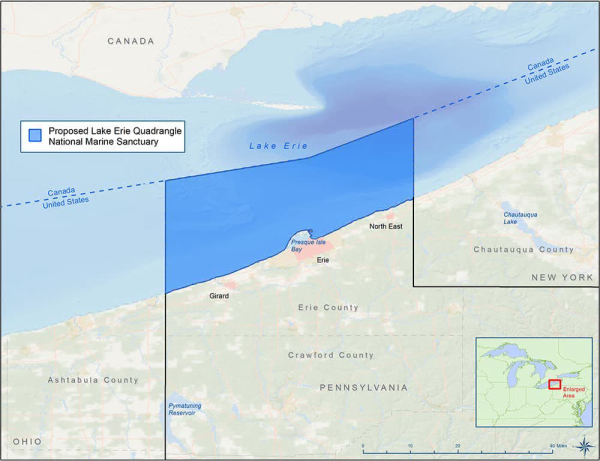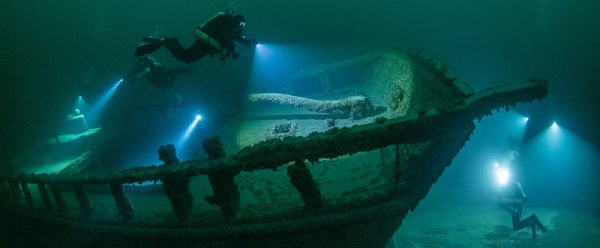
NOAA's Office of National Marine Sanctuaries is considering designating a new national marine sanctuary in Lake Erie, adjacent to Pennsylvania.
Sport fishing is not mentioned in the proposal, but some recreational anglers are nervous about the idea. “Sanctuary” sounds like “no fishing” to some. And this area is famed not only for the lunker smallmouths and walleyes of Lake Erie, but also for steelhead and salmon which grow fast in the lake and then run up the rivers in fall and early winter.
This could be good—that is it’s assumed that fishing will be part of the uses allowed as it has always been. But some anglers are concerned that it could be bad, particularly if some “fish feel pain” types gear up and cram the meetings prior to the designation. Diving is also not mentioned, but all the remarkable shipwrecks in the area currently welcome cold-water divers.
NOAA’s Marine Sanctuary page says this: “The majority of the collective waters in national marine sanctuaries are open to recreational fishing, providing opportunities for anglers of all ages and fostering a sense of responsibility for America's great outdoors.”
But remember, this is your federal government at work. There is no telling where bureaucracy may take us once the process starts. And the statement says “the majority”—not “all”.
Erie County, Pennsylvania submitted a nomination in 2015, and NOAA is now considering sanctuary designation to protect the region's maritime heritage resources, including a nationally significant collection of shipwrecks. As part of the designation process, NOAA will establish a local Sanctuary Advisory Council—and it would be wise for local anglers and divers to volunteer to serve on this council.
The proposed Lake Erie Quadrangle National Marine Sanctuary would encompass approximately 740 square miles of Pennsylvania's Lake Erie waters, from the shoreline to the Canadian border. Approximately 75 miles of the proposed sanctuary shoreline would be in Erie County.
NOAA says this area represents a historically and culturally rich region where the long relationship between human activity and the maritime environment has created “meaning and a sense of place, which is expressed and preserved in a wide variety of maritime cultural resources, from sacred places and cultural practices, to lighthouses and historic shipwrecks.” Together, these tangible and intangible elements form a rich maritime cultural landscape.

Nearly every type of vessel that operated on the Great Lakes during the 19th and 20th centuries is represented in the area being considered for sanctuary designation. Based on historical records, 196 vessels may have sunk within the Pennsylvania waters of Lake Erie, and 35 of these shipwrecks have been identified.
The known shipwrecks span from the 1838 steamboat Chesapeake to speedboats, tugs, barges, and workboats lost before 1940. The collection includes schooners, brigs, and barks; barges and schooner barges; dredges and sand suckers; fishing tugs and trawlers; and sidewheel steamboats and propellers. This area also includes the potential for submerged prehistoric sites and historic properties that may be of religious and cultural significance to Indigenous nations and tribes.
If designated, NOAA's activities would complement the Commonwealth of Pennsylvania's efforts to preserve and interpret the area's importance, including its collection of nationally significant historic shipwrecks and other underwater cultural resources. With this designation, NOAA says it could:
Submitting Comments
The public can comment on the proposed action through July 18, 2023. Comments may be submitted by any one of the following methods:
In-person public meeting 1
Date and Time: Wednesday, June 21, 2023, 6:30 - 8:00 p.m. ET
Location: Erie, PA
Address: Erie County Public Library - Blasco
H.O. Hirt Auditorium
160 East Front Street
Erie, PA 16507
Virtual public meeting 1
Date and Time: Tuesday, June 27, 2023, 2:00 - 3:30 p.m. ET
Registration: attendee.gotowebinar.com/register/5727142095178900822
Virtual public meeting 2
Date and Time: , June 28, 2023, 6:30 p.m. - 8:00 p.m. ET
Registration: attendee.gotowebinar.com/register/3840871623612958300
Submit comments online
Submit all electronic public comments through the Federal eRulemaking Portal, www.regulations.gov. The docket number is NOAA-NOS-2023-0039. Click the "Comment Now!" icon, complete the required fields, and enter or attach your comments.
—- Frank Sargeant
Frankmako1@gmail.com
Sargeant is editor of our companion service, The Water Wire.